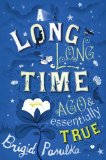Baba Yaga
This article relates to A Long, Long Time Ago and Essentially True

In A Long, Long Time Ago…And Essentially True, one of the
main characters, Beata, is constantly referred to by the nickname "Baba Yaga."
Baba Yaga is a popular figure in Slavic folk tales (Slavic
language map). Also known as the "Old Woman
of Autumn," her origins can be traced back to the ancient Slavic goddesses of birth
and death. The derivation of her name is not clear: "baba," is an abbreviated form
of the word "babushka," the Slavic term for an old woman or grandmother;
but the origins of "Yaga," are more muddy - possibly it is a corruption of "yagat" (to abuse or find fault), possibly it is from a Proto-Slavic word meaning lazybones, or it could simply be a diminutive of the Slavic name Jadwiga (a Polish variation of the German name Hedwig).

A powerful witch, she's generally depicted as a hideous crone,
with a long, warty nose, dirty, stringy hair, and steel teeth that make a fearsome noise when she gnashes them. Her mode of transport is a giant mortar, which she steers with a pestle in one hand, while in the other she carries a broom to sweep away her tracks. She is sometimes considered a source of wisdom, but more often the tales refer to her as someone who kidnaps and eats children.
Baba Yaga's residence is a small hut on chicken's legs that dances around at will. It has no visible doors or windows. Anyone seeking to enter must say, "Turn your back to the forest and your front to me," at which point the hut rotates and lowers to allow entry. Baba Yaga herself frequently enters via the chimney. The hut is surrounded by a fence of human bones topped by skulls. Interestingly, although the house on chicken legs sounds like the stuff of pure fantasy, it is possible that it is an interpretation of a type of construction popular among the nomadic hunters of Siberia which is designed to protect supplies from animals during long periods of absence. The doorless and windowless cabin is built on the stumps of two or more closely grown trees. As you can see from the illustration - the spreading roots of the trees do give the impression of chicken legs!

Various servants appear in the tales. In many, Baba Yaga commands three horsemen: White (dawn), Red (noon) and Black (twilight). She's also said to have invisible servants who cook and clean for her, although in some stories her servants are various animals and inanimate objects.
The most common Baba Yaga story concerns a young woman who is sent to Baba Yaga under false pretenses by her evil stepmother. In both instances, the witch gives the girl impossible tasks to complete, hoping that she'll fail and that she'll then be able to eat the girl for dinner. In one version, the girl consults a magical doll that her mother gave her on her deathbed, which helps her make prudent decisions and therefore survive the encounter (
read a version of the story). In the other (which is believed to be a later
Christianized version) the girl shows compassion for Baba Yaga's servants (giving ham to a cat, cheese to a mouse and breadcrumbs to a bird), which then reciprocate by helping her escape. (In some regions, this latter tale features
two children – a boy and a girl – the precursor of the German fairy tale "Hansel and Gretel.") The stories are told to children to discourage them from straying too far from home. The first also encourages children to listen to their intuition, while the second promotes being kind to others.
Filed under Places, Cultures & Identities
 This "beyond the book article" relates to A Long, Long Time Ago and Essentially True. It originally ran in October 2009 and has been updated for the
May 2010 paperback edition.
Go to magazine.
This "beyond the book article" relates to A Long, Long Time Ago and Essentially True. It originally ran in October 2009 and has been updated for the
May 2010 paperback edition.
Go to magazine.
This review is available to non-members for a limited time. For full access become a member today.
Membership Advantages
- Reviews
- "Beyond the Book" articles
- Free books to read and review (US only)
- Find books by time period, setting & theme
- Read-alike suggestions by book and author
- Book club discussions
- and much more!
-
Just $45 for 12 months or
$15 for 3 months.
- More about membership!



![]() This "beyond the book article" relates to A Long, Long Time Ago and Essentially True. It originally ran in October 2009 and has been updated for the
May 2010 paperback edition.
Go to magazine.
This "beyond the book article" relates to A Long, Long Time Ago and Essentially True. It originally ran in October 2009 and has been updated for the
May 2010 paperback edition.
Go to magazine.





